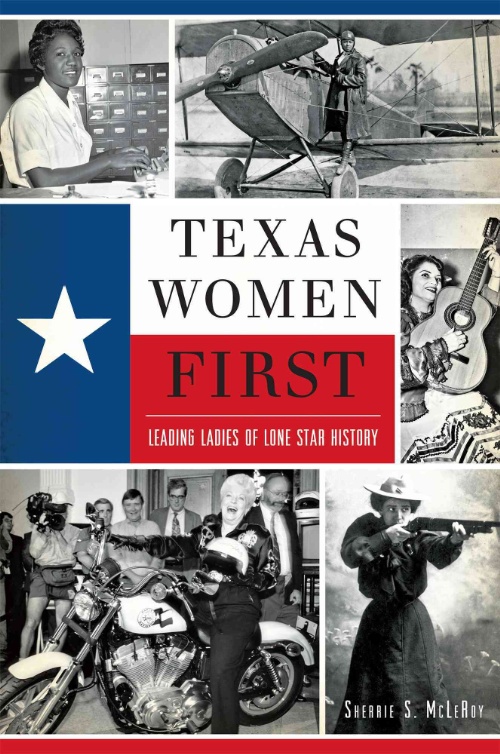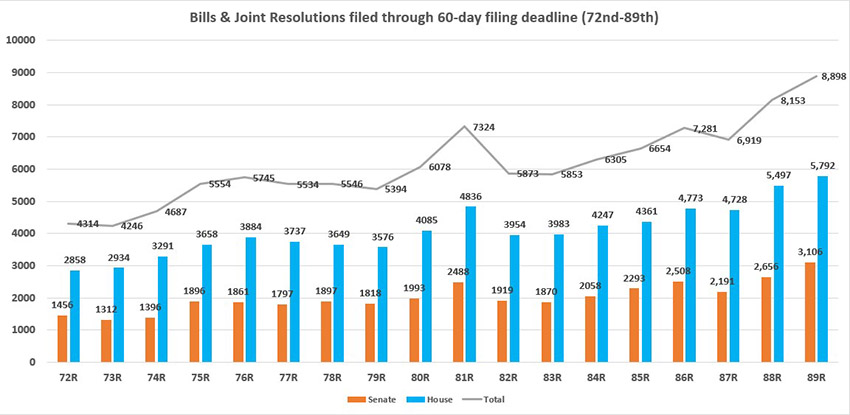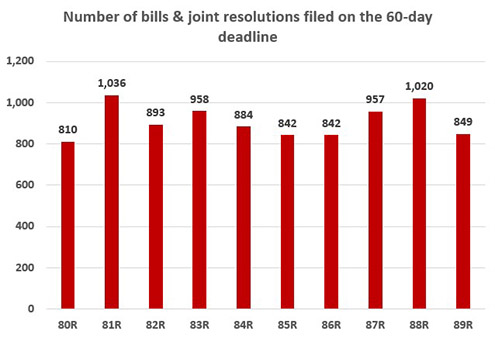New & Noteworthy titles are available to Legislative offices and agencies. To borrow an item, please submit an online request through the New & Noteworthy page on our website or contact the library at 512-463-1252.

1. Women Across Time = Mujeres a Través del Tiempo: Sixteen Influential South Texas Women
By Susan L. Roberson, editor
Features the sixteen South Texas women represented in the public mural Mujeres a Través del Tiempo (Women Across Time) by former State Representative Arnold Gonzáles, Sr., housed on the campus of Texas A&M University–Kingsville. Examines the lives of ranchers, educators, politicians, artists, and others who served the community. Includes biographies of former State Representatives Frances "Sissy" Farenthold and Irma Rangel.
Texas A&M University Press, 2022, 233 pages
976.4 R638W 2022

2. Women's Suffrage in Texas: Struggle, the Story: Successes, Notable Firsts: Senators, Women of the Texas Senate
By Texas Senate
Reflects on the legislative efforts, struggle for suffrage, and achievements of women in Texas in celebration of the 100th anniversary of the Nineteenth Amendment. Provides brief biographies of significant women in Texas, including former and current Texas Senators. Notes that since the first woman was elected to a statewide office a century ago, Texas women have served at every level of state and local government.
Includes — chronological by first election — former and current State Senators Margie E. Neal, Maribell Stewart, Neveille Colson, Barbara Jordan, Betty Andujar, Cyndi Krier, Eddie Bernice Johnson, Judith Zaffirini, Peggy Rosson, Jane Nelson, Florence Shapiro, Leticia Van de Putte, Joan Huffman, Wendy Davis, Donna Campbell, Sylvia Garcia, Lois Kolkhorst, Konni Burton, Dawn Buckingham, Carol Alvarado, Angela Paxton, Beverly Powell.
Texas Senate, 2019, 63 pages
L1803.8 W842 2019

3. Women in Texas History
By Angela Boswell
Provides a chronological overview of women's history in Texas, from Native American Texas to the end of the twentieth century. Considers physical, geographic, legal, political, social, and cultural factors that challenged and shaped Texas women's roles in creating the state of Texas. Includes political female "firsts" across the spectrum of politics. Mentions State Representative Senfronia Thompson and State Senator Judith Zaffirini, along with former State Senator Leticia Van de Putte and former State Representatives Irma Rangel and Sarah Weddington; former Ambassador Kay Bailey Hutchison; and former U.S. Representative Barbara Jordan.
Texas A&M University Press, 2018, 345 pages
305.409764 B657W 2018

4. Texas Women First: Leading Ladies of Lone Star History
By Sherrie S. McLeRoy
Celebrates the contributions and achievements of a mix of unconventional, trailblazing women in the Lone Star state. Profiles famous and not-so-famous women who broke barriers in areas as diverse as aeronautics, government, arts and entertainment, business, education, medicine, law, military, and social justice. Highlights memorable "firsts" accomplished by Texas women, including former State Representative Frances "Sissy" Farenthold and former Ambassador Kay Bailey Hutchison.
The History Press, 2015, 188 pages
979 M154T 2015

5. Texas Women: Their Histories, Their Lives
By Elizabeth Hayes Turner, Stephanie Cole, and Rebecca Sharpless, editors
Compiles a collection of biographies and essays of Texas women showing the racial, class, and religious diversity of the Lone Star State, from the Spanish colonial era to the twenty-first century. Explores the lives of Native American, European, African American, and Hispanic women and their impact on Texas. Focuses on a range of topics, including the influence of Spanish law; slavery; higher education; equal rights; civil rights; politics; business; ranching; and the arts. Provides essays on Oveta Culp Hobby and former U.S. Representative Barbara Jordan.
The University of Georgia Press, 2015, 526 pages
305.409764 T852T 2015

6. Texas Dames: Sassy and Savvy Women Throughout Lone Star History
By Carmen Goldthwaite
Highlights the stories of 53 Texas women and their accomplishments from early Tejas to the mid-twentieth century. Details how these courageous "Dames" broke both gender and racial barriers in education, ministry, business, entertainment, athletics, medicine, and politics. Profiles women who achieved "firsts" as doctors, scientists, bankers, attorneys, religious leaders, and state lawmakers. Highlights former State Senator Margie E. Neal and former State Representative Edith Eunice Wilmans.
The History Press, 2012, 157 pages
976.4 G58T 2012

7. Texas Through Women's Eyes: The Twentieth-Century Experience
By Judith N. McArthur and Harold L. Smith
Offers an overview of women's achievements in Texas throughout the twentieth century with a focus on rural, working-class, and minority women. Discusses women's roles in working for social and political reform, the right to vote, better opportunities in education and the workforce, and civil rights. Provides a selection of primary documents including letters, memoirs, and oral histories.
Mentions State Representative Senfronia Thompson; former State Representatives Frances "Sissy" Farenthold, Helen Moore, Irma Rangel, and Sarah Weddington; Judge Sarah T. Hughes; former Ambassador Kay Bailey Hutchison; and former U.S. Representatives Eddie Bernice Johnson and Barbara Jordan.
University of Texas Press, 2010, 295 pages
305.4209764 M127T 2010

8. Black Women in Texas History
By Bruce A. Glasrud and Merline Pitre, editors
Explores how African American women have affected the culture and history of Texas while also showing how they have been shaped by the larger culture. Compiles essays written by era experts to provide a survey of African American women's experiences through time and themes, including slavery and freedom; Reconstruction; the Civil Rights Era; and more. Argues that often-disenfranchised Black women actively pursued ways to make their voices heard and build community.
Mentions State Representative Senfronia Thompson, former State Representative Wilhelmina Delco, and former U.S. Representatives Eddie Bernice Johnson and Barbara Jordan.
Texas A&M University Press, 2008, 248 pages
325.26 B64W 2008

9. Rough Road to Justice: The Journey of Women Lawyers in Texas
By Betty Trapp Chapman
Examines how the legal profession has been the hardest of all professions for women to break into, due to sexual discrimination that was historically rooted in the legal system. Describes the challenges and limitations women endured in 1902, the year the first woman was allowed to practice law in Texas. Highlights the courage of women as they continued to face obstacles even into the 21st century. Points out that despite the obstacles, women lawyers today comprise more than 31 percent of the State Bar of Texas and 48 percent of law students in the state.
Mentions State Representative Senfronia Thompson; former State Representatives Lanell Cofer, Susan Combs, Debra Danburg, Frances "Sissy" Farenthold, Patricia Hill, Irma Rangel, Sue Schechter, Elizabeth Suiter, Sarah Weddington, and Edith Wilmans; former State Senator Cyndi Taylor Krier; former Judge Sarah T. Hughes; former Ambassador Kay Bailey Hutchison; and former U.S. Representative Barbara Jordan.
State Bar of Texas, 2008, 267 pages
340.092 C366R 2008

10. Las Tejanas: 300 Years of History
By Teresa Palomo Acosta and Ruthe Winegarten
Celebrates the contributions made to Texas by women of Spanish/Mexican origin from the 1700s to 2000. Provides a historical account of Tejanas in all aspects of life, focusing on their struggles and triumphs in politics; education; the arts; and business. Profiles notable Tejanas, including former and current members of the Texas Legislature. Supplements this history of achievements with a selection of photographs and artwork.
Mentions current and former legislators including State Senators Judith Zaffirini and Leticia van de Putte and State Representatives Diana Davila, Jessica Farrar, Lena Guerrero, Christine Hernandez, Irma Rangel, and Elvira Reyna.
University of Texas Press, 2003, 436 pages
301.45 AC72T 2003

11. "Let Me Tell You What I've Learned": Texas Wisewomen Speak
By PJ Pierce
Presents a collection of interviews of twenty-five women who have led extraordinary lives and shaped Texas in significant ways. Shares the wisdom and life lessons of women who have broken barriers and challenged stereotypes. Features risk-takers from a variety of backgrounds, including former and current lawmakers, who offer insights into topics such as career challenges; being a minority; families; faith; adversity; perseverance; and success.
Mentions State Senator Judith Zaffirini; former State Representatives Wilhelmina Delco, Irma Rangel, and Sarah Weddington; former Ambassador Kay Bailey Hutchison; and former U.S. Representative Barbara Jordan.
University of Texas Press, 2002, 302 pages
920.7209764 P611L 2002

12. Capitol Women: Texas Female Legislators, 1923-1999
By Nancy Baker Jones and Ruthe Winegarten
Examines the Texas Legislature through the experiences and history of the 86 women who have served as state legislators from the 38th Legislature to the 75th Legislature (January 1923 to January 1999). Includes 4 essays for cultural context. Provides chronological biographies on 58 women and snapshots of 28 women.
University of Texas Press, 2000, 328 pages
328.764 J722C
This entry was posted on March 5, 2025 at 3:40 PM and has received 1203 views.
Print this entry.
















